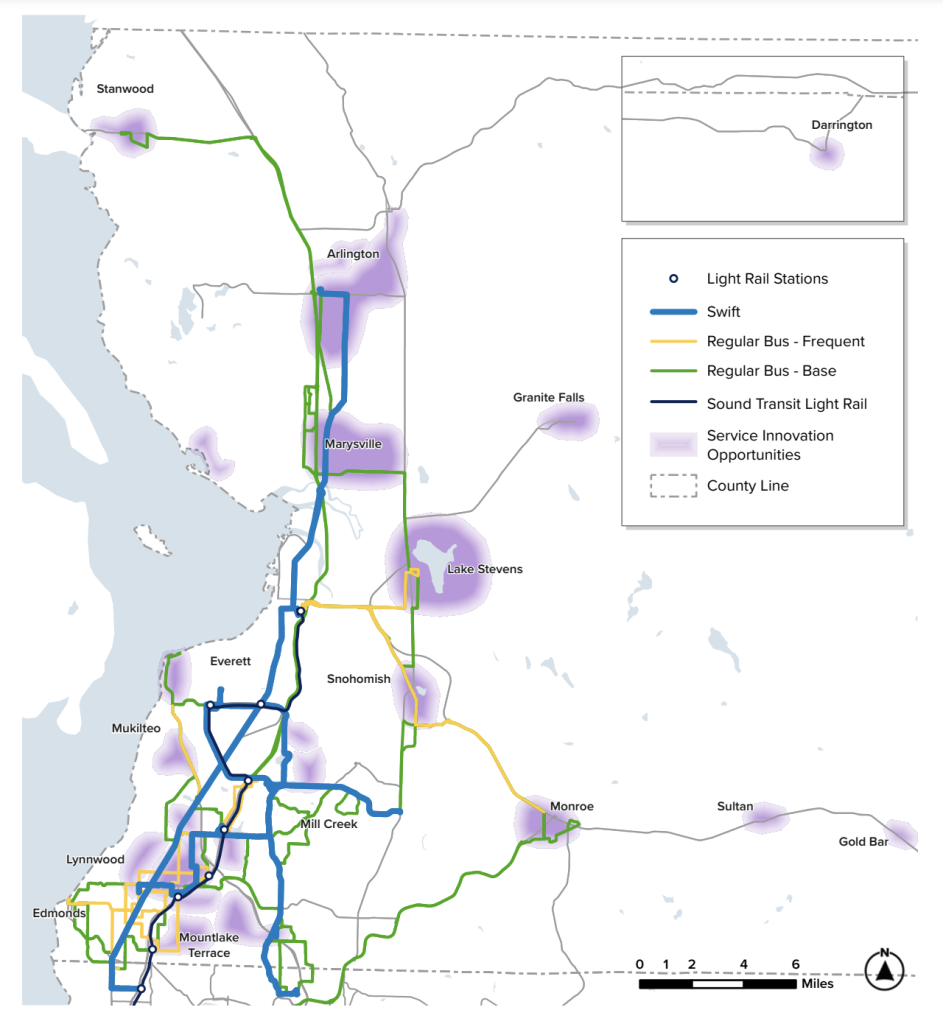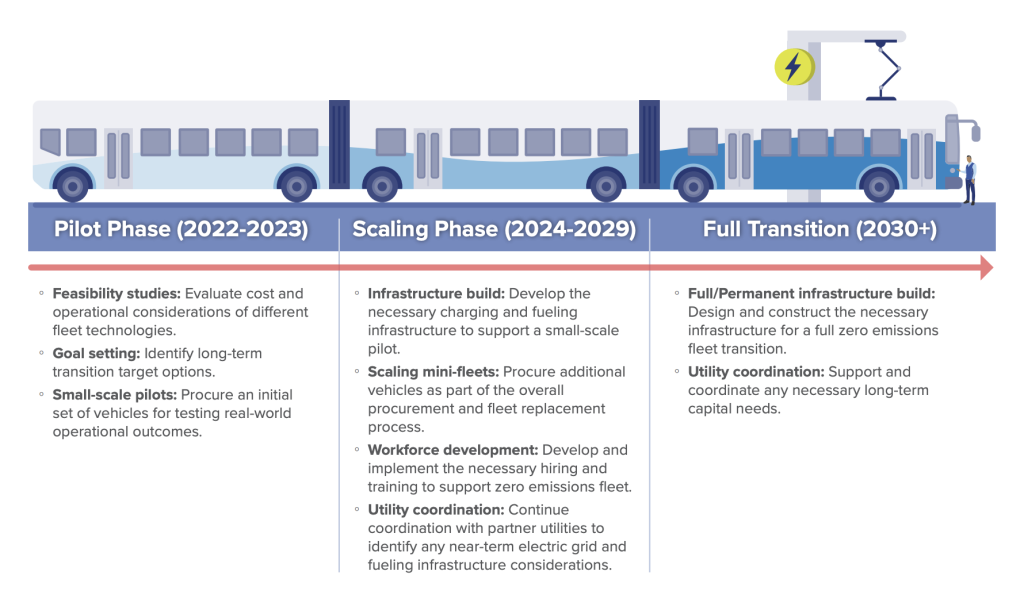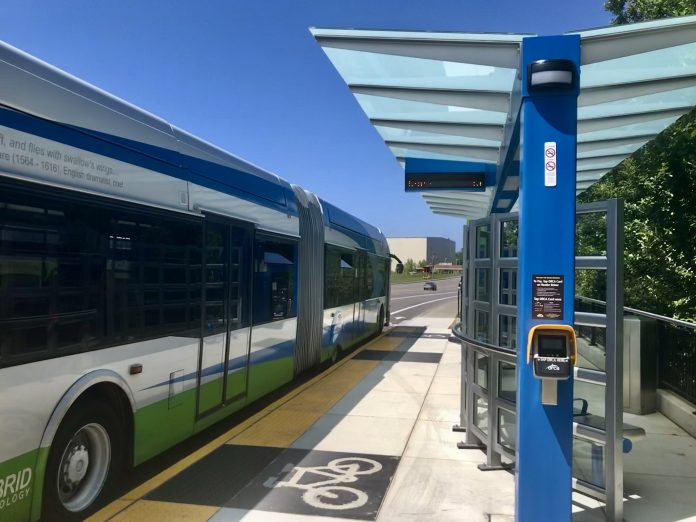
Snohomish County’s bus network will grow, with frequent routes and feeders for light rail.
Community Transit’s new long-range plan and adopted 2024 budget offers quite a bit of optimism for the future. Next year promises to delivery the agency’s newest Swift bus rapid transit (BRT) line, extend its oldest BRT line, and redeploy some bus service for better local transit service. The long-range plan also charts service growth and a modernized transit system.
2024 service and budget highlights
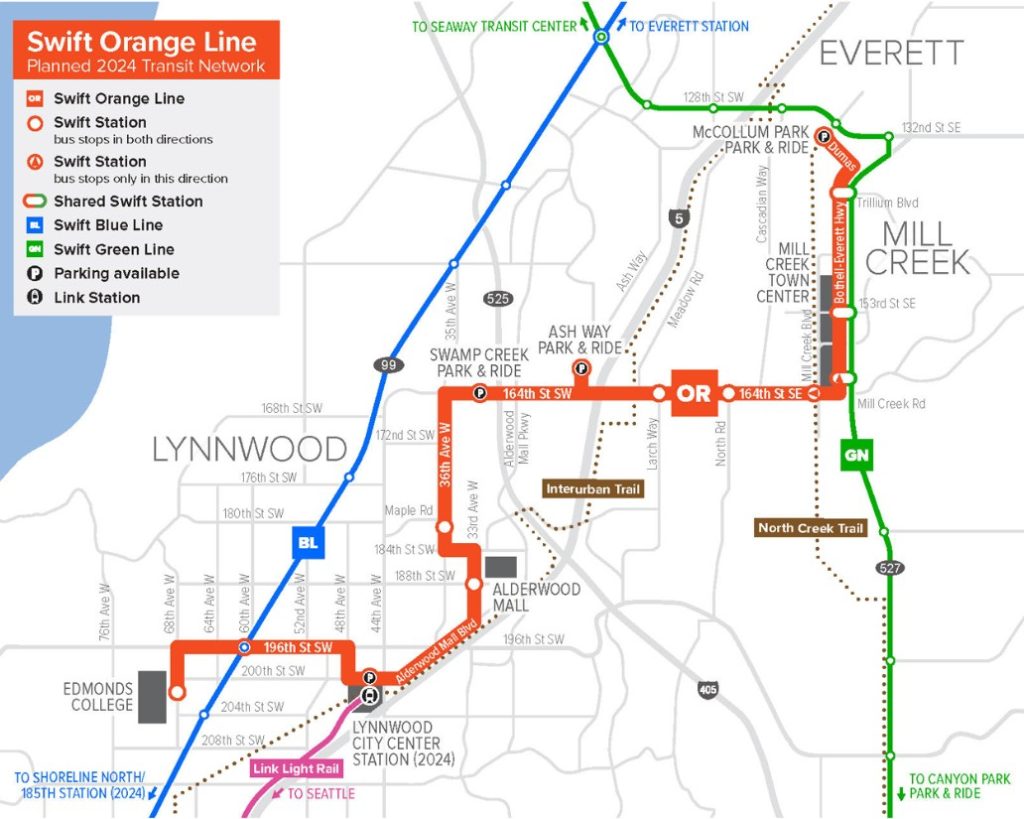
In March, Community Transit plans to open the Swift Orange Line between Edmonds College and Mill Creek via Lynnwood and Ash Way. The new 11-mile line will offer frequent service between numerous major community destinations and urban areas. Span of service on the Orange Line will be substantial and on weekdays regular daytime service will be every 10 to 12 minutes. During early morning, nights, and on weekends, service be operate about every 15 to 20 minutes.
Then in the fall, the Lynnwood Link Extension will open, bringing light rail to Shoreline, Mountlake Terrace, and Lynnwood City Center. Community Transit intends to open an extension of the Swift Blue Line from Aurora Village to Shoreline North/185th Station. This will offer a better connection for riders in the southern portion of Snohomish County to light rail.
Along with the new Swift Orange Line and Lynnwood Link openings, Community Transit will be redeploying a lot of service hours and begin implementation of its new local bus system. Changes will phase in during March and August with further phases coming later in 2025 and 2026. These changes ultimately will mean more service in more areas for more riders inside Snohomish County, in part because commuter routes will be further truncated or eliminated.
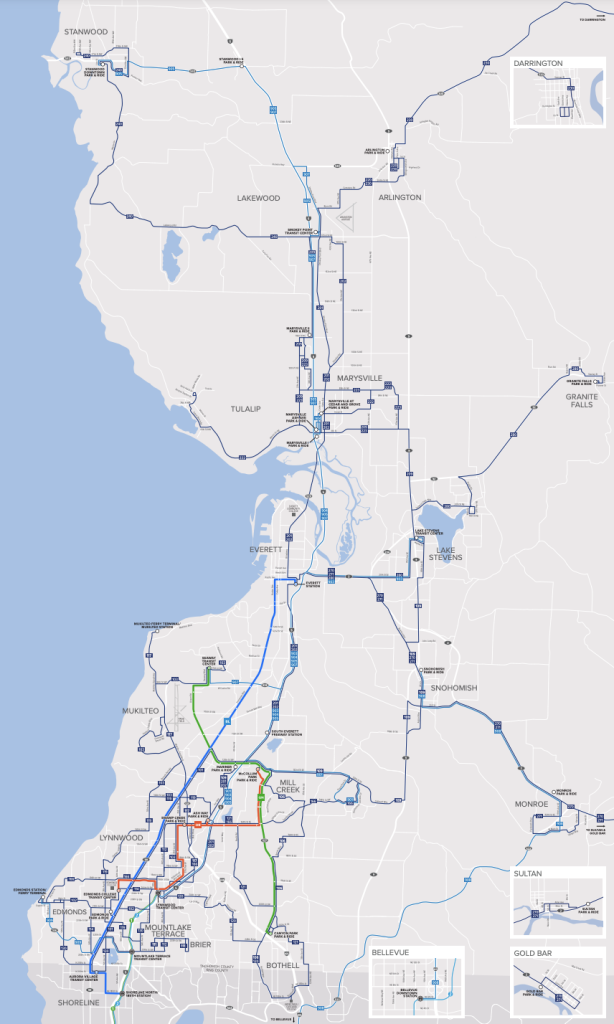
Total annual service hours are expected to top 497,000 in 2024, an increase of about 62,000 from 435,000 this year. For services operated on behalf of Sound Transit, Community Transit is also anticipating delivery of nearly 80,000 annual service hours next year, a growth of about 10,000 from 70,000 this year. While next year’s service growth is a positive trend, it will still take several more years to fully restore annual service hours to pre-pandemic levels.
Other key priorities in the 2024 budget, include:
- 43 more operations and maintenance positions, bringing the total to 641 positions.
- $8.5 million for design and engineering for the future Swift Gold Line (Everett-Arlington).
- Maintaining the on-demand Zip Alderwood shuttle and piloting similar efforts in Arlington, Darrington, and Lake Stevens.
- Maintaining safety with 18 transit security officers, contracts with the Snohomish County Sheriff’s Office, and other strategies.
- $1.1 million to provide new digital and static signage as well as improved station amenities at existing Swift Blue and Green Line stations.
- $1.1 million to replace aging ticket vending machines at Swift stations.
- $960,000 to provide new onboard digital signage for Swift vehicles.
- $65.6 million for procurement of 19 60-foot hydrogen fuel cell buses and 10 40-foot battery electric buses to be delivered in 2027.
Along with the procurement of new zero-emissions vehicles, Community Transit will test two zero-emissions buses, one battery-electric and the other a hydrogen fuel cell, in regular revenue service — both 40-foot long coaches.
In terms of finances, Community Transit’s total 2024 operating budget is expected to top $231.5 million in expenditures and $273.3 million in revenue. While that is financially positive, there is some cause for concern since the agency is heavily reliant on a 1.2% sales tax for revenues. The 2024 budget expects those revenues to come in at around $206.7 million, a 2.1% increase from $202.4 million this year. Tax growth has slowed in the past two years and hasn’t kept up with inflation, so that could create future pressures. However, agency economists believe that sales tax growth will rebound to traditional 4% growth rates in the period from 2025 through 2028. Inflation is also expected to be in check by then.
On the capital side, Community Transit is allocating $202.8 million in system improvement expenditures, which is a little lower than this year but still substantially elevated from prior years.
Long-range plan highlights
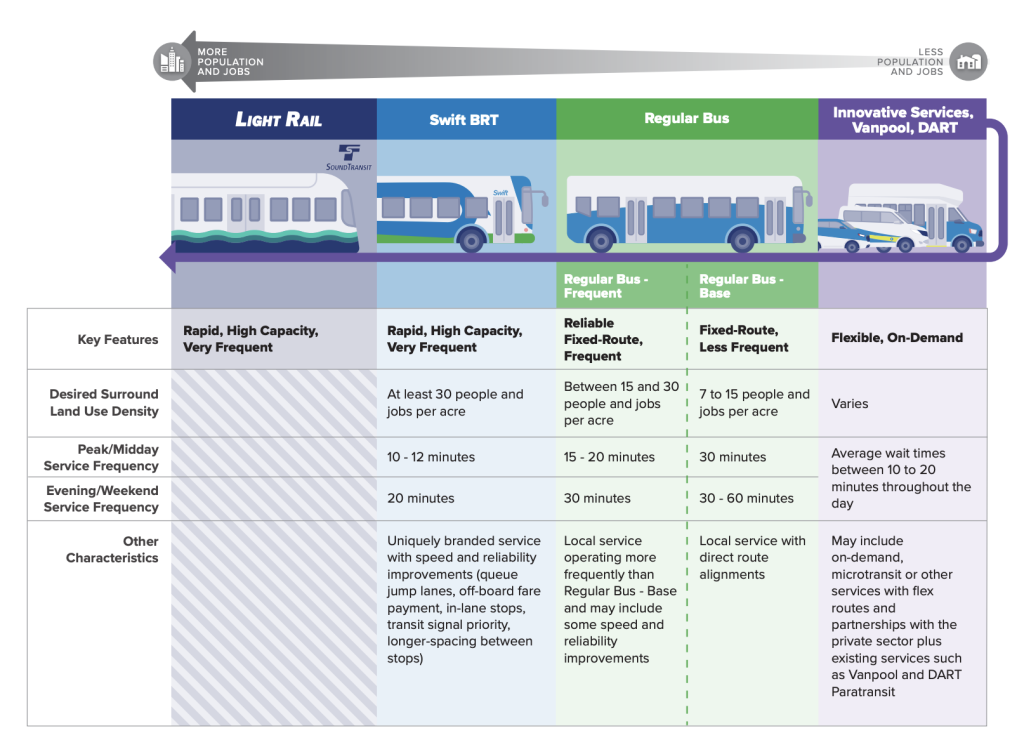
As Community Transit evolves, the long-range plan to 2050 calls for significant changes to the fixed-route system, with a priority around regular bus service and BRT. It also emphasizes the need to plan for and support flexible services. This by extension means fully phasing out express commuter bus routes.
The agency’s plan has a breakdown of future service shares in terms of annual revenue hours: 40% regular bus service, 30% BRT service, and 30% flexible service. The biggest growth of service in the plan is flexible service with BRT further behind. Nevertheless, Community Transit says that over 70% of service would be frequent or flexible by 2050, meaning that riders only experience wait times between five and 15 minutes.
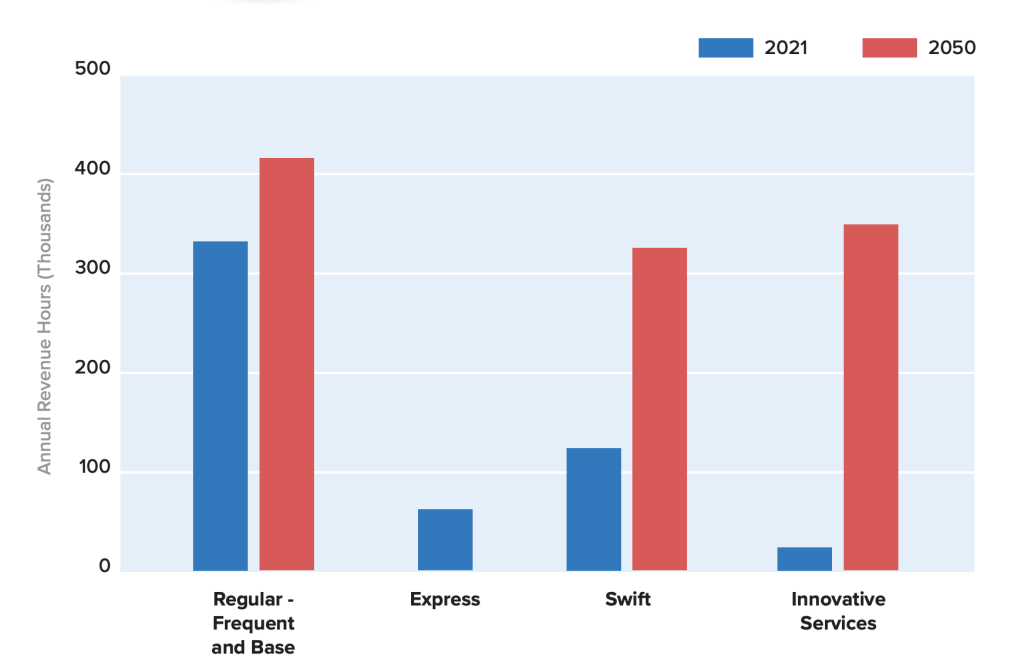
While the balance of investment in flexible service is heavy, it is important to put that in the context of the vast service area Community Transit has. The agency has a charge to cover almost every urban area in Snohomish County and the areas in between. Fixed-route transit service makes sense on main corridors and between key destinations, but many of the areas served are very low density with few plans to change that in the decades ahead outside of the Southwest Urban Growth Area (SWUGA), city and town centers, or key corridors like SR 99, SR 527, or Link light rail.
As a consequence, Community Transit’s system plan identifies a large number of flexible service areas in towns like Darrington, Stanwood, Monroe, and Sultan where fixed-route transit service would be highly challenged to capture much ridership. The plan also identifies flexible service area pockets in the SWUGA where densities are low and similarly hard to serve with traditional fixed-route transit service.
Nevertheless, the system plan calls for an extensive network of base regular bus service (trips about every 30 minutes), frequent regular bus service (trips about every 15 minutes), and BRT (trips often more frequently than every 15 minutes). BRT lines would stretch from Arlington to Shoreline, Bothell, and Mill Creek with a particular emphasis in Everett and the central part of the SWUGA. Layered on top of this would be a substantial network of base regular bus service for mid-sized and and larger cities and dense unincorporated areas. Frequent regular bus service would primarily be focused on key SWUGA corridors and near denser areas within the SWUGA as well as between Everett and its eastern suburbs of Lake Stevens, Snohomish, and Monroe.
Not shown in the system plan are less frequent bus routes between places like Darrington and Arlington or Sultan and Monroe, but Community Transit is likely to provide some level of fixed-route service between these locales. “The intent of the map is to show that future investment in those areas would likely be focused on identifying more flexible and innovative service models,” Monica Spain, a spokesperson for Community Transit, told The Urbanist. “We don’t intend to take away existing service. And we would take a community’s needs into consideration when designing future service models (including connections to more metropolitan areas).”
To support transit service in the decades ahead, Community Transit intends to establish a speed and reliability team to monitor specific congestion hotspots in Snohomish County. Those hotspots include numerous highway sections like US-2, SR 99, SR 527, and SR 529 as well as key streets like 164th Street SW and 35th Avenue SE. The speed and reliability team will also be responsible for coordinating with local and state partners to develop improvements for transit.
“Improvements can include transit signal priority, bus queue jumps, dedicated transit lanes, bus bulbs, and level boarding, among others,” the long-range plan states. “There is also interest in expanding bus-only lanes along the Swift network wherever feasible.”
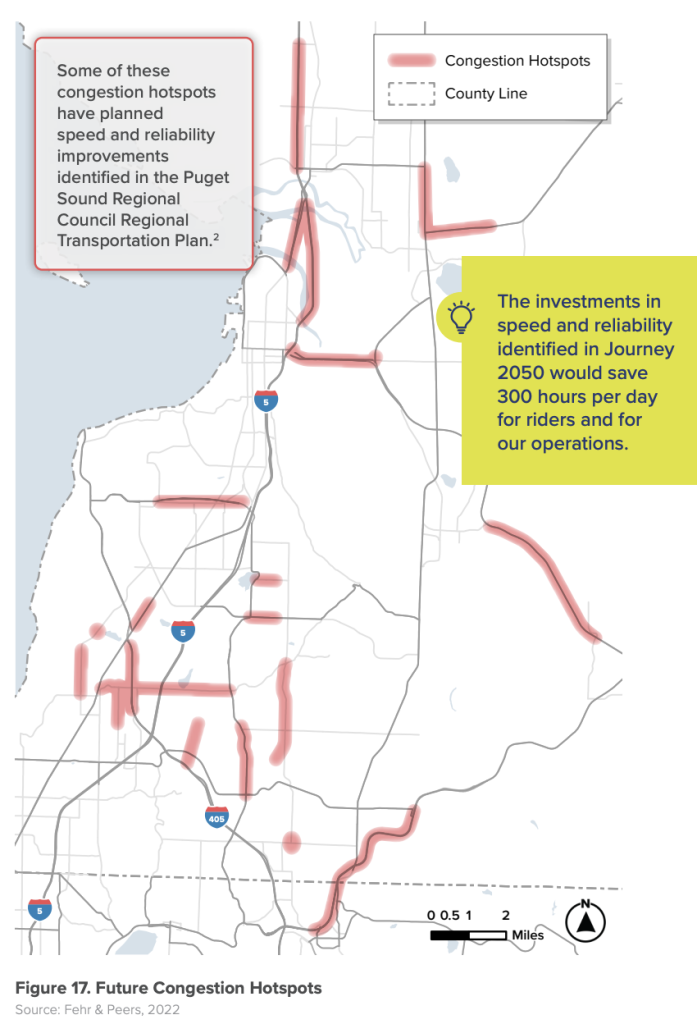
In the coming years, the plan directs Community Transit to adjust its bus fleet makeup, largely by phasing out 60-foot articulated buses on non-BRT routes. The overall fleet would slightly increase, but mostly by replacing 60-foot articulated buses with 40-foot buses. This reflects the agency’s desire to focus on local bus service and expansion of Swift. As a result, the number of 60-foot articulated buses would increase a little to support expansion of the BRT services. Community Transit may also continue to invest in a small fleet of 30-foot double-deckers for specific service needs.
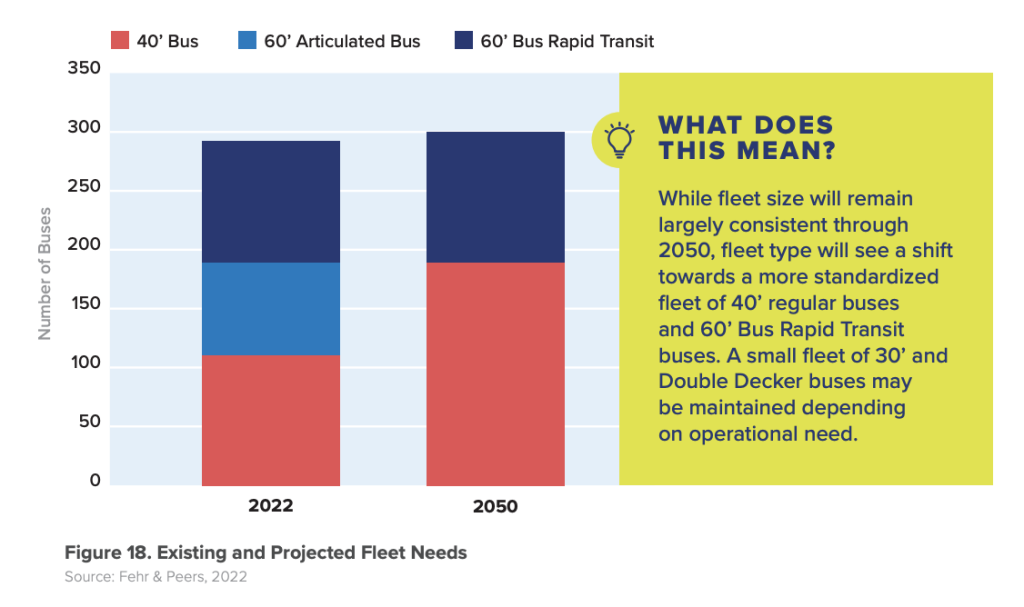
Community Transit plans to advance work on its journey to a zero-emissions transit system. The agency is taking a wiser and slower path to electrification by learning how zero-emissions vehicles can integrate into the system. Unlike the general transportation sector, non-wire zero-emissions transit vehicles are still in their infancy and pose many more logistical challenges due to their operating requirements. The agency’s long-range plan therefore is taking a more cautious and realistic approach to setting a full zero-emissions conversion target in 2044 whereas King County Metro is on a much more risky timeline to reach full fleet zero-emissions by 2035.
Not accounted into Community Transit’s long-range plan, however, is the proposed merger with Everett Transit. If and when a merger does go through, the plan would need to be updated to reflect the combined service area’s priorities and goals. But the plan does provide a good window into what that would mean for Everett, which is likely higher transit service levels.
Stephen is a professional urban planner in Puget Sound with a passion for sustainable, livable, and diverse cities. He is especially interested in how policies, regulations, and programs can promote positive outcomes for communities. With stints in great cities like Bellingham and Cork, Stephen currently lives in Seattle. He primarily covers land use and transportation issues and has been with The Urbanist since 2014.


